Estimated reading time 12 minutes, 53 seconds.
In the hour or so after sunrise on a foggy, humid day in mid-July, Saugeen Municipal Airport in rural southwestern Ontario, near the small town of Hanover, was an oasis of calm.
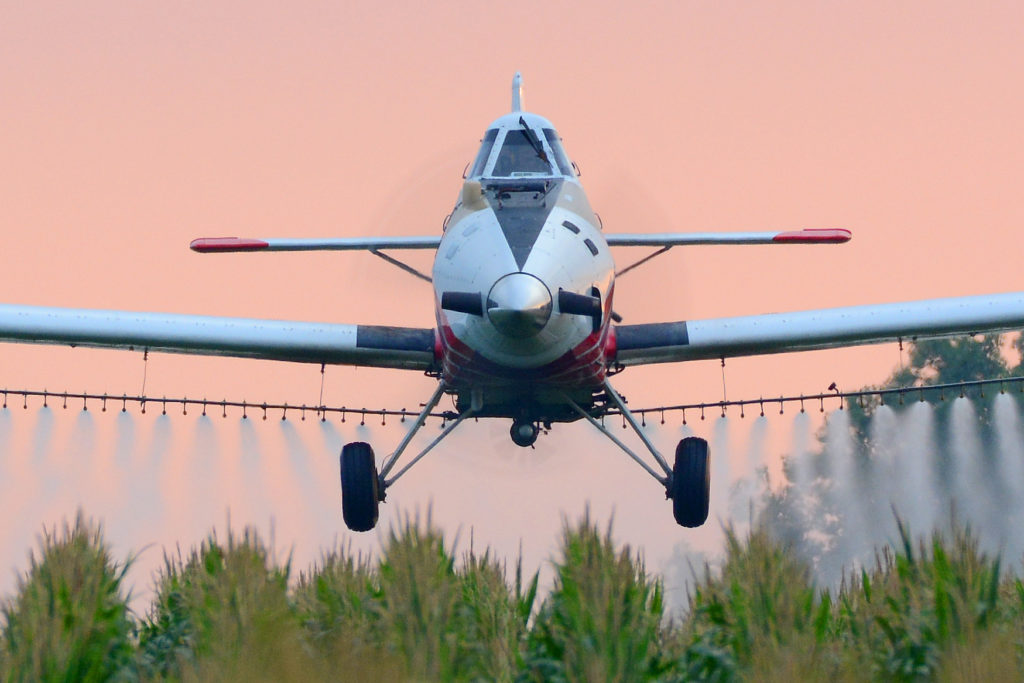
Birds chirped intermittently and insects hummed as dew clung to the shiny fuselage of a twin-engine Diamond DA-42-TDI, the only aircraft parked within striking distance of the 4,500-foot asphalt runway.
This is farm country, where 50-acre plots of corn–the kind destined for animal feed and ethanol production–spring up from some of the most fertile soil in the province, in gently-rolling fields bordered by thick woodlots.
Over the next 45 minutes, the airport comes to life.
A DA-42 pilot arrives, goes through pre-flight checks, starts the engines, taxis and takes off. Cars begin to fill the parking lot, and staff in the terminal restaurant serve their first customers of the day.
At 8:36 a.m., the activity builds to a steady buzz.
David Hodgins, a pilot and aircraft maintenance engineer (AME) for General Airspray, one of the top agricultural spraying companies in Ontario, touches down in a white single-engine Piper PA-18 Super Cub, and quickly sets to work.
Dressed in bright orange and yellow coveralls, clear safety goggles and a faded ball cap, he exits the plane and walks to a pair of transport trucks parked at the end of the taxiway, one hauling a trailer filled with fungicide and another supporting 14,000-litre tanks of water and 4,500 litres of avgas.
Minutes later, two more General Airspray pilots touched down in Grumman G-164 Ag-Cat biplanes, iconic crop-spraying aircraft that date to the late 1950s and still serve as the workhorses of the General Airspray fleet.
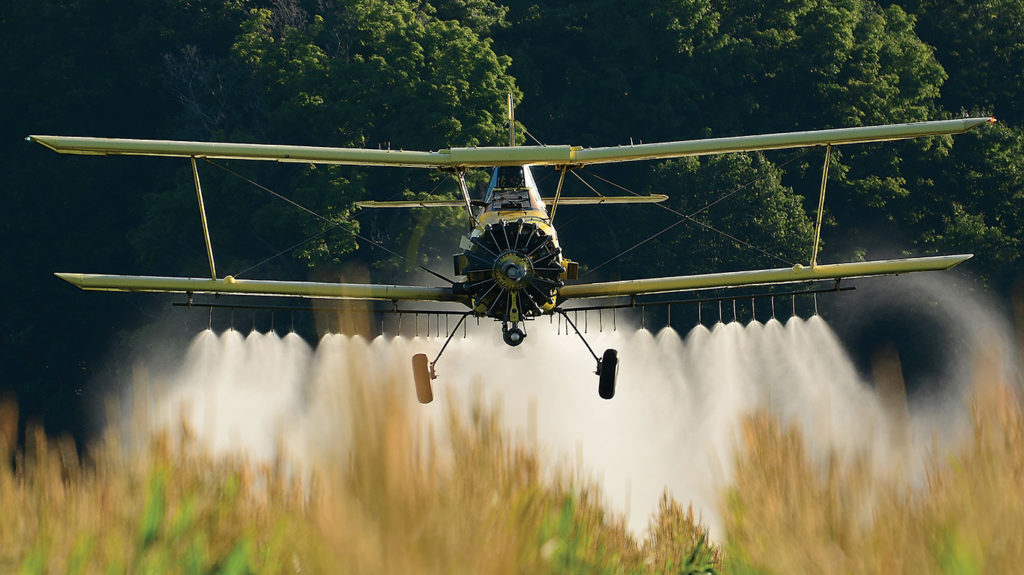
company has four Ag-Cats in its fleet. Eric Dumigan Photo
The Ag-Cats, mustard yellow with grey-brown stripes that bear the General Airspray logo, taxi toward the trucks and Hodgins begins hauling hoses toward them, mixing fungicide with water and quickly filling their 330-gallon (1,250-litre) tanks.
He fills one Ag-Cat, then the other, and they launch into the sky, flying low and slow over hundreds of acres of corn, releasing the fungicide mixture in a gentle mist.
Hodgins suddenly finds himself in a bit of a lull, with little to fill it until the Ag-Cats finish spraying and return to the airport for another load.
He’s been up since 4 a.m., already logged several hours of planning and flying, and his day won’t finish until late in the evening.
This is the nature of the work, and he enjoys it. But, as it would with most people, the physical stress takes its toll.
“The early hours are not for everyone, that’s for sure,” he said.
“Getting up in the morning and then working till dark and then getting up again in the morning can be pretty strenuous.
“You kind of get used to it, I guess–a bit.”
RURAL ROUTE
Based in a small rural compound with three aircraft hangars and its own 3,000-foot grass strip near Lucan, Ont., a town of 2,500 people just north of London, General Airspray is simultaneously impressive and low-key.

The company operates four Grumman Ag-Cats, four Piper Super Cubs and one Thrush 510P turbine aircraft, covering thousands of acres over the busy summer crop spraying season.
There are few other agricultural spaying companies in this part of the province, where corn, soybeans, white beans and wheat are staple crops that dominate a landscape dotted with small towns near the shores of Lake Huron and Lake Erie. General Airsrpay covers thousands more acres during the spring and fall. It uses the Super Cubs to plant Jack Pine and Black Spruce trees in northern Ontario, New Brunswick, Saskatchewan and Quebec, reforesting harvested and fire-scarred woodlots using a Brohm broadcast seeding device.
The company also plants about 2,000 acres of cover crops every year, using aircraft to plant rye and oats in corn and soybean fields to replenish them with nitrogen and prevent soil erosion.
General Airspray crews and maintains the Thrush, a 2014 model acquired last year, on behalf of another spray company that has a contract in Quebec spraying for spruce budworm, an insect that defoliates coniferous plantations.
“It’s actually a bacteria that we spray, the caterpillar eats the spray, and it gives them an ulcer,” explained Paul Hodgins, owner of General Airspray and David’s father.
“So it’ll stop feeding on the tree, and then eventually it’ll die. But if a bird comes along to eat that dead caterpillar, it won’t affect the bird. It only affects the caterpillar. So it’s a very specific product, and then within seven to 10 days it naturally degrades.”

All this with a full-time workforce of three people–David, Paul and Stephen Hogg, a long-time pilot who is apprenticing to be an AME–and a seasonal crew of three additional pilots.
“It’s a precision job,” said Paul. “It’s a nice fit with forestry seeding in the winter/spring time, and then back in the shop getting aircraft ready for budworm and then the spraying season starts… by the end of the season you’re anxious to get back into the shop.”
HUMBLE BEGINNINGS
General Airspray traces its roots back to 1962, when the late Roscoe Hodgins–Paul’s father–and his partner, the late Doug Worgan, bought out the spraying business of Leavens Brothers, a Toronto-based company later known as Leavens Aviation.
Roscoe and Worgan bought four Boeing-Stearman Model 75 biplanes from Leavens Brothers, focusing mainly on forestry and agricultural spraying, and operated from St. Thomas Municipal Airport until 1971.
They bought a farm near Lucan that year that previously belonged to Harvey Hodgins, Roscoe’s father, and built their first aircraft hangar later that year.
Worgan retired around 1985 and Roscoe bought a 100 per cent stake in the company, operating it with Paul’s help until Paul purchased the company in the early 2000s.
Paul grew up around the family business, rarely flying but always in close proximity to aircraft. He trained as an AME at Confederation College in Thunder Bay in the late 1970s and apprenticed at a helicopter company in Calgary in the early 1980s before switching over to fixed-wing maintenance.
He returned to Ontario in the fall of 1983 and trained to become a private pilot at the London Flying Club the next year, receiving his commercial pilot’s licence in 1986.
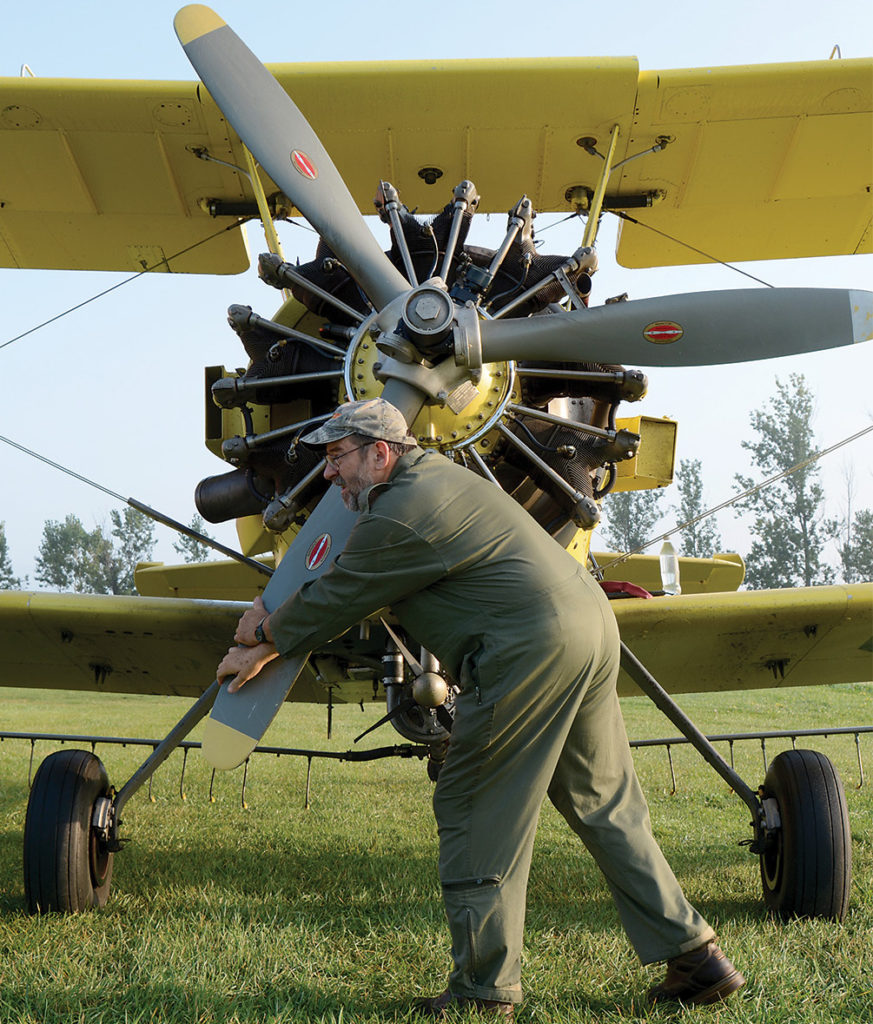
A year later, he started flying the Super Cub for General Airspray, focusing on broadcast tree seeding for three seasons before starting agricultural spraying with the Ag-Cats.
General Airspray acquired its first Ag-Cat in 1969, a second in 1975, then retired the last of its Stearmans the same year. In 1976 it acquired another Ag-Cat, adding the fourth and final aircraft of that type to its fleet in 1981.
“They’re a good short-field machine,” said Paul, referring to the Ag-Cat. “They can get in and out of a farmer’s grass strip, [and] still take a load.
“The new Thrush that we’re operating and maintaining for another company–it’s faster, but with a single wing it takes a little more runway to get off. So it’s a little bit better suited for a paved strip.”
Ag-Cats were the first aircraft specifically designed by a major OEM for agricultural use, and they are considered one of the most successful models in the genre, with nearly 2,700 built since Grumman introduced them in 1957.
While standard Ag-Cats have a 300-U.S. gallon (1,135-litre) hopper for liquid and seed, General Airspray models have a slight bulge on the top of the tank that provides an additional 30 gallons (113 litres).
The aircraft have 600-horsepower Pratt & Whitney R-1340 radial engines, overhauled at 1,000- to 1,400-hour intervals at Tulsa Aircraft Engines in Tulsa, Okla. Hope Aero of Mississauga, Ont., overhauls the Ag-Cats’ propellers.

“It’s very easy on the controls,” said Hogg, a veteran pilot who has flown everything from the Pilatus PC-12 to the Cessna Caravan and Beech 1900 at various other companies over the last 10 years.
“I don’t feel like I’m muscling the airplane around, like I’m using a lot of effort, especially in the one airplane … it’s extremely easy on the controls. It has servos on all the flight control surfaces, but it was just easy to fly. It was very docile.”
At six-foot-three, Hogg said it can be difficult to get in and out of the Ag-Cat.
“It’s pretty tight for a tall guy like me,” he said. “But I wouldn’t say I’ve had any challenges flying it.”
ICONIC AIRCRAFT
With a 750-horsepower Pratt & Whitney turbine engine, the Thrush 510P is significantly faster and more efficient than the venerable Ag-Cats.
Its working speed is 135 to 145 miles per hour (217 to 233 km/h), compared with the 105 to 110 mph (169 to 177 km/h) pace of the Ag-Cats.
The Thrush has a 510-gallon (1,930-litre) hopper, dispensing liquid for the budworm contract with six rotary atomizers compared to four in the Ag-Cats, allowing it to spread over wider swaths of field with each pass.
“It has air conditioning, so you stay nice and cool on the hot summer days,” said Hogg. “I could fly all day long in that, and I wouldn’t get too tired.”
While the Ag-Cat was iconic for its era, turbine aircraft from Thrush and Air Tractor have since become the industry standard.
“But you have to be 10 steps ahead of it,” said Hogg, referring to the Thrush. “It’s a fast airplane.”
The Super Cub is equally revered, and perhaps Hogg’s favourite in the fleet.
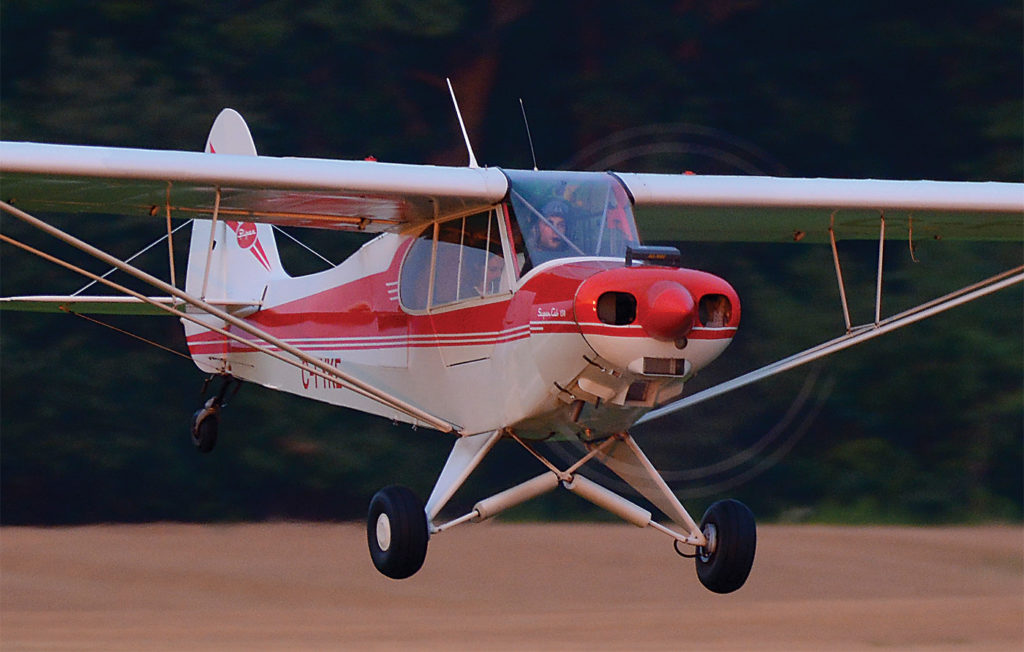
The rugged, two-seat monoplane has a single 150 horsepower Lycoming engine and an 80-kilogram seed tank that can treat up to 1,000 acres with a single tank load.
“My first year, we went up to do herbicide work out of Dryden [Ontario], and Paul asked me what I wanted to fly,” said Hogg.
He remembers responding with: “If I can fly the Cub, I’ll fly the Cub all day long.”
“It’s just very iconic,” he said. “A lot of people will say, ‘If you can fly a Cub, you can fly–this airplane,’ if they’re talking about another airplane.”
CHALLENGES
Aerial spraying is a way of protecting the huge investment farmers put into their fields each spring, helping them avoid yield loss believed to be caused by soil compaction and crop trampling when tractors tow ground sprayers through the field.
“When we put the fungicide on, the main thing is plant health,” said Paul Hodgins. “It keeps the plant greener longer, and it’s a stronger plant to stand through the fall. If they get the timely rains during the season, then they are going to get a yield boost.”
It’s also a more efficient way of spraying fields, but in lean years it’s an expense some farmers may avoid. That’s one of the key challenges facing General Airspray, whose business model depends in part on the economic health of the farming community.
“We’re at the whim of the commodity prices … as far as the agricultural work,” said Paul. “And the forestry, still, is based on the economy, too.”
During the recession that began in 2008, companies that tilled the ground to prepare it for aerial tree reforestation closed up, creating a significant challenge for General Airspray.
“Now that the [reforestation] work has come back, there’s less of those companies doing that work,” said Paul. “So we don’t get enough ground prepared for us to be able to treat. So the last couple of years our numbers have been up and down, just because they haven’t been able to get their ground tilled.”
It’s also difficult to find experienced pilots, given General Airspray has all tail-wheel aircraft and performs specialty aerial application work.
While the pilot shortage has not yet affected the company, Paul predicts it eventually will.
“We’re all getting older,” he said.
NOT OLD YET
It’s worth noting that, as he filled the Ag-Cats with fungicide near Hanover that muggy morning in mid-July, David Hodgins was still a few months short of his 25th birthday.

While everyone in General Airspray’s small cadre of pilots and maintainers is getting older, it will be decades before most of them are old.
And for his part, David’s plan is to stick around.
“That’s my main goal,” he said. “Hopefully next year, I’ll be doing some of the spraying.”
General Airspray is its own approved maintenance organization (AMO), caring for its fleet and nearly a dozen additional private aircraft over the winter.
“We stay fairly busy in the off-season,” said David.
Paul’s hope is to sustain the level of forestry and agricultural spraying the company has now, perhaps increasing it slightly, while also increasing the amount of maintenance work it takes on.
“It’s been five or six years since we’ve had all four Super Cubs operating in the winter time, just with the level of work,” said Paul. “But it would be nice to get all four working again.”
As for David, who grew up around the family business, the variety of work and chance to travel seem to overshadow the early mornings and long hours.
“It’s kind of always been in my blood,” he said as he waited for the Ag-Cats to return to Saugeen airport for their second load of the day.
“I would say I’m more of a morning person, so I don’t mind getting up.
“But I will say that after two weeks of getting up at four o’clock in the morning and working 16-hour days–four o’clock gets pretty tiring, sometimes.”
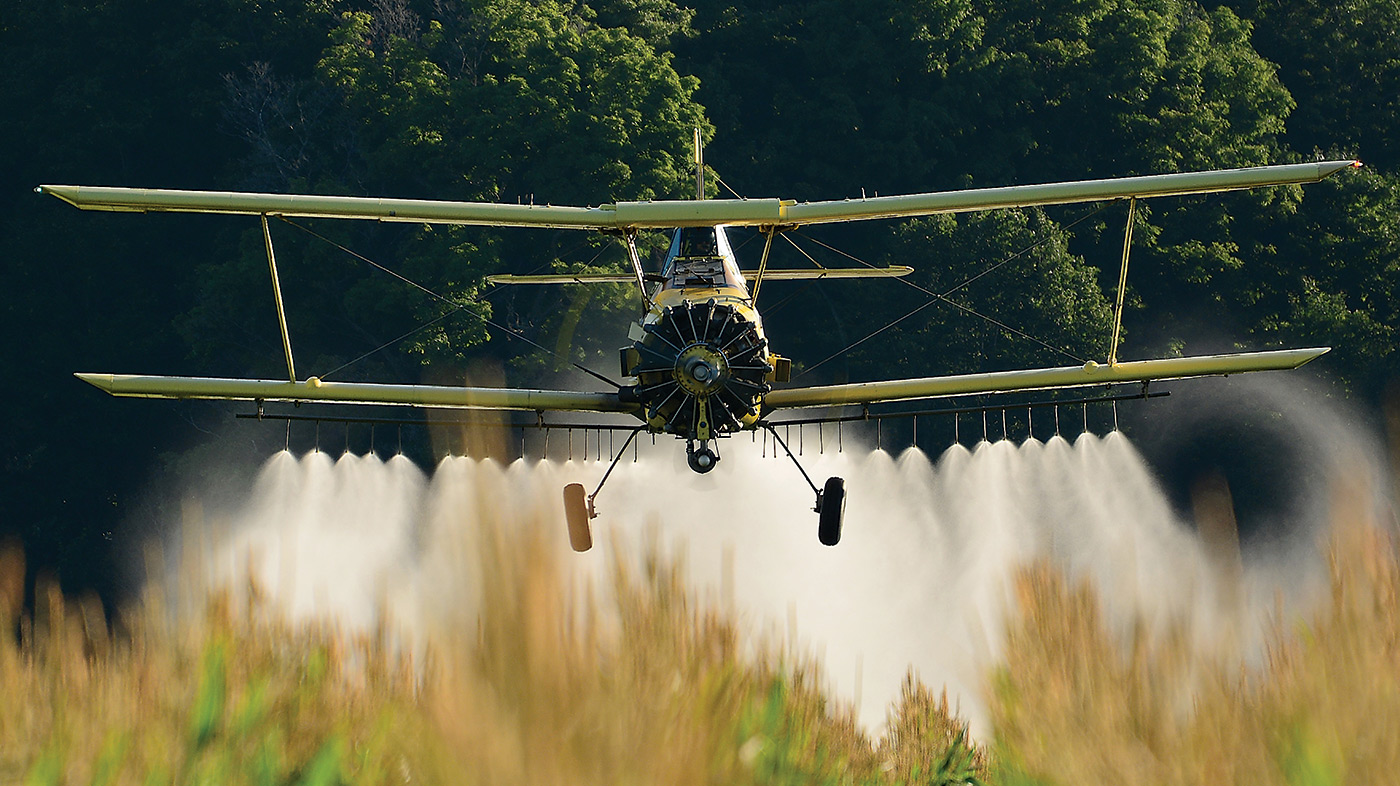

Man!!! I wish I lived near this flying service!! I’d beg for a ground crew job just to be up-close with a front row seat to the air show. I’d be the most dogged worker they ever saw.
Great article!
Fortunate to have them close by.
these guys and their planes are a common site in this area… often hear them early mornings . and often wave as we pass each other in the air.. Professional pilots and good friends.